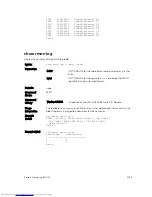
If you do not enable
shutdown-on-violation
, BPDUs are still sent to the RPM
CPU.
You cannot enable STP root guard and loop guard at the same time on a port. For
example, if you configure loop guard on a port on which root guard is already
configured, the following error message displays:
% Error: RootGuard is
configured. Cannot configure LoopGuard
.
Enabling Portfast BPDU guard and loop guard at the same time on a port results in
a port that remains in a Blocking state and prevents traffic from flowing through it.
For example, when Portfast BPDU guard and loop guard are both configured:
• If a BPDU is received from a remote device, BPDU guard places the port in an
Err-Disabled Blocking state and no traffic is forwarded on the port.
• If no BPDU is received from a remote device, loop guard places the port in a
Loop-Inconsistent Blocking state and no traffic is forwarded on the port.
Example
Dell(conf)#interface gigabitethernet 4/0
Dell(conf-if-gi-4/0)#spanning-tree rstp edge-port
Dell(conf-if-gi-4/0)#show config
!
interface GigabitEthernet 4/0
no ip address
switchport
spanning-tree rstp edge-port
no shutdown
Dell#
tc-flush-standard
Enable the MAC address flushing after receiving every topology change notification.
Syntax
tc-flush-standard
To disable, use the
no tc-flush-standard
command.
Defaults
Disabled
Command
Modes
CONFIGURATION (conf-rstp)
Command
History
Version 8.3.16.1
Introduced on the MXL 10/40GbE Switch IO Module.
Usage
Information
By default, the system implements an optimized flush mechanism for RSTP. This
implementation helps in flushing MAC addresses only when necessary (and less
often), allowing for faster convergence during topology changes. However, if a
standards-based flush mechanism is needed, you can turn on this
knob
command
to enable flushing MAC addresses after receiving every topology change
notification.
Rapid Spanning Tree Protocol (RSTP)
1151
















































